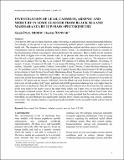DSpace@İHÜ
INVESTIGATION OF LEAD, CADMIUM, ARSENIC AND MERCURY IN SOME SEAFOOD FROM BLACK SEA AND MARMARA SEA BY ICP-MASS SPECTROMETRY
JavaScript is disabled for your browser. Some features of this site may not work without it.
| dc.contributor.author | İnal Erdem, Gizem
|
|
| dc.contributor.author | Özpınar, Haydar
|
|
| dc.date.accessioned | 2019-07-06T07:57:33Z | |
| dc.date.available | 2019-07-06T07:57:33Z | |
| dc.date.issued | 2017 | |
| dc.identifier.uri | http://hdl.handle.net/11547/2536 | |
| dc.description.abstract | Over the last 200 year our planet has been under a threat due to industrilization and environmental pollution. Accordingly, all the species living in our environmentally polluted planet is potentially a majör source of health risk. This situation is also directly leading to making the seafood and other species of waterborne is contaminated with the industrial pollutants such as heavy metals. The contaminated foods are suitable for the dissemination of these carcinogenic chemicals through the consumers. Heavy metals are the members of the third or higher rows of the periodic scale. In the present time, there are many heavy metals more than 60 such as lead, cadmium, chromium, cobalt, copper, nickel, mercury and zinc. The objective of this study was to analyze Pb, Cd, Hg, As in a total of 150 seafoods (10 shrimp, 10 calamari, 10 octopus, 10 mussel, 10 acorn, 10 mackerel, 10 coral, 10 sea bream, 10 whiting, 10 sole, 5 horse mackerel, 5 anchovy, 5 sardine, 5 bluefish, 5 gray mullet, 5 turbot, 5 red mullet, 5 coral, 5 bream, 5 butts fish) from Marmara Sea (n=75) and Black sea (n=75) by using Inductively Coupled Plasma-Mass Spectrometer ICP-MS according to the criterias by both Turkish Food Codex Declaration About Maximum Limits of Contaminants in Food Products (Declaration No: 2008/26) and NMKL 186 International method. The results revealed that the lead levels in both horse mackerel (0,385 ppm) and mullet (0,387 ppm) , and the mercury levels in both red mullet (1,707 ppm) and sea bream (1,098 ppm) from the Black sea were found to be higher, whereas the lead levels in both sardine (0,417 ppm) and butts fish (0,843 ppm) from Marmara Sea were higher than the upper limits as declared by Turkish Food Codex. In the mussels collected from Marmara Sea, the cadmium levels were found to be nearly close to the upper limit, which was 1 ppm. Also, it was provided that all the samples contained arsenic. However, no comment was performed since the Turkish Food Codex does not indicate any upper limit for itself. In Conclusion, this study provided that the seafoods collected from both Black sea and Marmara Sea significantly included heavy metals, including lead, mecury, cadmium, and arsenic. This situation leads to a significant foodborne health riskfor the public health and the Turkish consumers. | tr_TR |
| dc.language.iso | en | tr_TR |
| dc.publisher | International Journal of Food Engineering Research (IJFER) | tr_TR |
| dc.subject | Heavy metal | tr_TR |
| dc.subject | Fish | tr_TR |
| dc.subject | Blacksea | tr_TR |
| dc.subject | Cadmium | tr_TR |
| dc.subject | Arsenic | tr_TR |
| dc.subject | Mercury | tr_TR |
| dc.subject | Lead | tr_TR |
| dc.subject | ICP-MS | tr_TR |
| dc.title | INVESTIGATION OF LEAD, CADMIUM, ARSENIC AND MERCURY IN SOME SEAFOOD FROM BLACK SEA AND MARMARA SEA BY ICP-MASS SPECTROMETRY | tr_TR |
| dc.type | Article | tr_TR |
| dc.publisher.issue | 1 | tr_TR |
| dc.publisher.firstpagenumber | 1 | tr_TR |
| dc.publisher.lastpagenumber | 7 | tr_TR |
| dc.identifier.bibliographictag | İNAL ERDEM Gizem, ÖZPINAR Haydar, INVESTIGATION OF LEAD, CADMIUM, ARSENIC AND MERCURY IN SOME SEAFOOD FROM BLACK SEA AND MARMARA SEA BY ICP-MASS SPECTROMETRY(2017), International Journal of Food Engineering Research (IJFER) | tr_TR |
